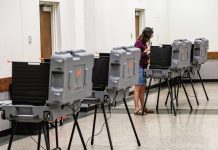COLUMBUS, Ind. — Columbus is still looking to reduce noise from trains, but there’s a lot of work left to be done before that could become a reality.
The Columbus Redevelopment Commission is entering in a contract with Alfred Benesch and Co. to assist in administrative details to create a “quiet zone” in Columbus. Redevelopment director Heather Pope said the contract amount is not to exceed $15,732.
This does not guarantee that the city will decide to create a quiet zone, she said.
The proposed quiet zone would include crossings at Fifth Street, Eighth Street, 11th Street and the State Road 46 pedestrian crossing. Safeguards include enhanced gates, as well as medians that prevent vehicles from driving around a gate.
Train engineers who are coming through Columbus are sounding their horns four times, as state law requires, at each of the four crossings within the city limits. That’s 16 times per train as they pass Fifth, Eighth and 11th street crossings and the State Road 46 pedestrian crossing.
About 13 trains routinely travel along this railroad line daily, sounding their horn for each public crossing as required by law. A study commissioned by the city indicates it could have as many as 22 trains a day in the future as L&I, which has leased the tracks to CSX, increases traffic on the line this year.
Under federal regulations, trains must sound their horns as they approach public grade crossings “in a standardized pattern of two long, one short and one long blasts.” The pattern must be “repeated or prolonged” until the leading car or locomotive occupies the crossing.
However, the Federal Railroad Administration allows cities to create quiet zones to lessen the noise, provided that certain requirements have been met.
In a “quiet zone,” railroads have been directed to cease the routine sounding their horns when approaching public highway-rail grade crossings. Trains may still sound their horns in certain circumstances, including if there is an emergency or if it is required by another federal regulation or railroad operating rule. To establish a quiet zone, a city must first implement measures to “mitigate the increased risk caused by the absence of a horn,” according to federal regulations.




